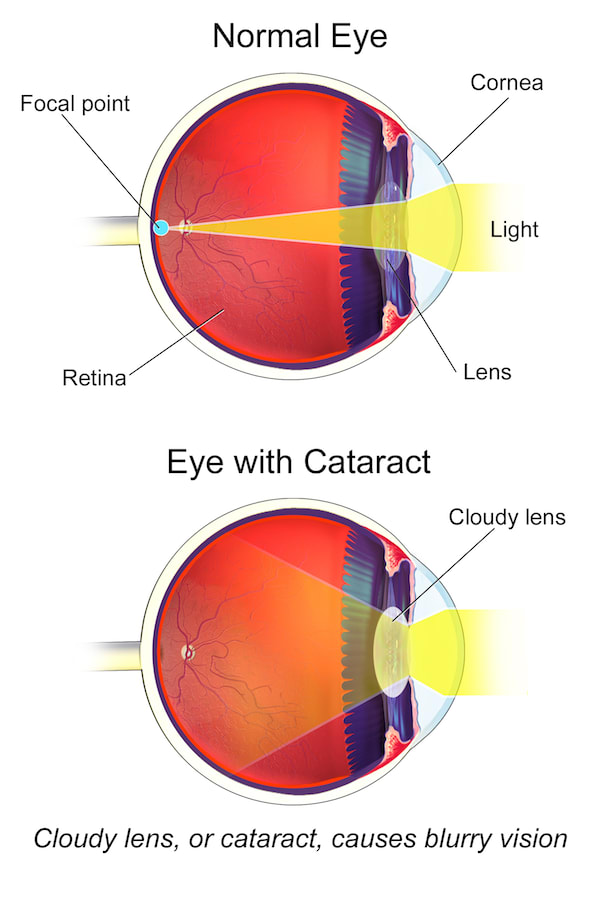Table of Contents
III. Risk Factors for Cataracts
What are Cataracts?
The eye is a very complex organ with many different parts. If any area of the eye is damaged or injured, then your vision can be affected. Cataracts are a condition that affects the lens of the eye. The lens is a transparent, biconvex structure suspended directly behind the iris of the eye. [1] However, for people with cataracts, all or part of this layer becomes cloudy and their vision can make it appear as if they are looking through a foggy window. This can make it difficult to do everyday activities, including driving, reading, and watching television.
In the United States, more than half of adults over the age of 80 either have cataracts or have had cataract surgery. It is not just elderly adults that can develop this condition; Around one in six adults over the age of 40 have cataracts. [2]
Symptoms of cataracts can appear very slowly. For many people, the condition can be so gradual that they may not be aware of their vision changes. Common symptoms of cataracts include:
- Vision that is cloudy or blurred
- Colors fading or becoming more yellowed
- Increased sensitivity to light
- Seeing halos around lights
- Finding night-time vision more difficult
- The need for increased or brighter light during reading or other activities
- Increased regularity for changes to eyeglasses prescriptions
- Double vision in a single eye [3]
The most effective way of treating cataracts is through cataract surgery. This involves replacing your natural clouded eye lens with a clear artificial lens. Cataract surgery is typically recommended when the condition begins to affect your everyday life. If you require surgery in both eyes, then this will typically be done at different times. Following surgery, eye drop medications such as Maxidex (dexamethasone) may be used to aid the healing process and to help prevent infection. [3] Keep reading to learn about the causes and risk factors for cataracts. Cataracts form in the lens of the eye. This is found behind the iris (colored part of the eye). The lens itself is olive-shaped and flexible. The flexibility is important as this allows it to change shape in order to change your focal distance. [1] Unfortunately, as a person gets older, their lens becomes thicker, less flexible, and less transparent. Cataracts form when tissues inside of the lens bunch together. When this occurs, cloudy areas appear within your vision. The cloudy area blocks light from passing into your eye, preventing you from seeing a sharp image. This is what causes blurred vision. Over time, the cataract grows and affects a wider part of your vision. As it develops, the clouding also becomes denser, making it more difficult to see. While cataracts can occur in both eyes simultaneously, it is often uneven. This causes a difference in your vision between your eyes. [3] There are several different risk factors that can increase your chance of developing cataracts. They include: One of the major factors for developing cataracts is increasing age. As mentioned previously, the disorder affects more than half of Americans over the age of 80. Usually, young people have a clear lens. Typically, the proteins in the lens tend to begin to break down after the age of 40. [4] While they may start forming in a person’s 40s or 50s, they usually do not affect vision until a person reaches their 60s. [5] Cataracts can also be caused by eye trauma. This can occur in several different ways, including an object or chemical penetrating the lens or radiation exposure damaging the lens. Eye trauma does not always need to penetrate the lens in order to cause cataracts. Blunt, forceful trauma such as being punched in the eye or being hit in the eye with a ball can also cause damage. While cataracts caused by an eye trauma may occur immediately, other injuries can take years to develop. Eye trauma can also lead to several other eye conditions, including glaucoma. If you do suffer an eye trauma, you should visit an eye doctor. [6] Another risk factor for cataracts is your family history. People that have a close relative with cataracts have a higher risk of developing the condition. While it is well-known that smoking can cause damage to your heart and lungs, it can also damage your vision. Smokers are twice as likely as non-smokers to develop cataracts. Heavy smokers (those that smoke 15 or more cigarettes a day) are three times more likely to develop this eye disorder. It is believed that smoking affects the lens of your eye by oxidation and may also lead to heavy metals accumulating in the eye. [7] There are several medical conditions that can also increase your risk of cataracts. One of these conditions is diabetes. For people that have diabetes, keeping your blood sugar levels under control can help reduce your risk. [8] The content in this article is intended for informational purposes only. This website does not provide medical advice. In all circumstances, you should always seek the advice of your physician and/or other qualified health professionals(s) for drug, medical condition, or treatment advice. The content provided on this website is not a substitute for professional medical advice, diagnosis, or treatment.
How Cataracts Form

Risk Factors for Cataracts
a. Increasing Age
b. Eye Trauma

c. Family History
d. Smoking
e. Diabetes
